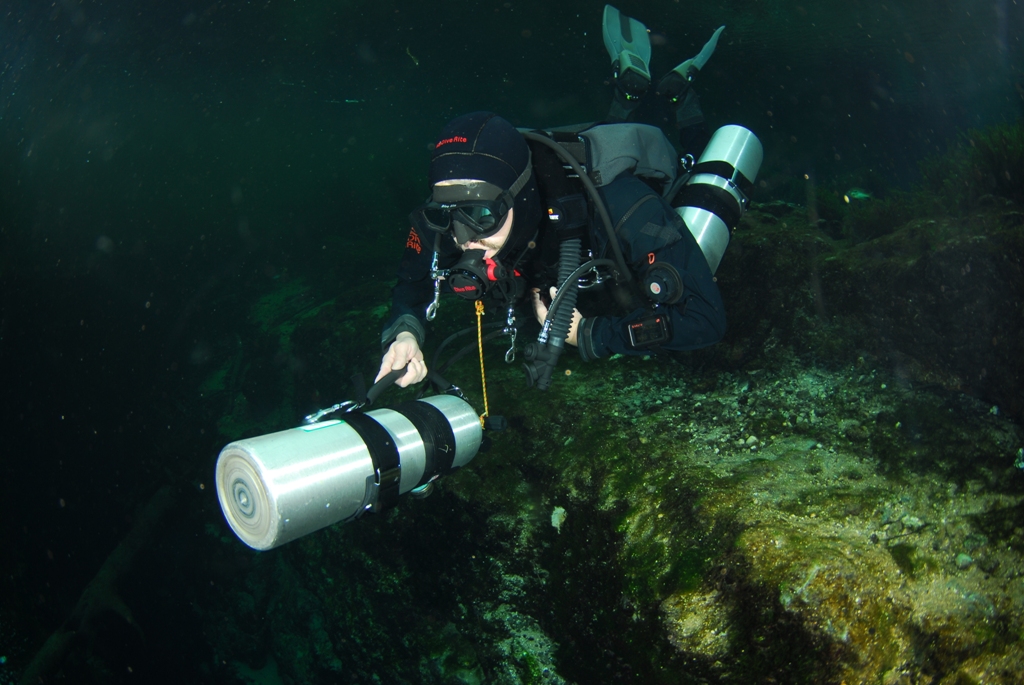|
Rule Of Thirds (diving)
In scuba diving, the rule of thirds is a rule of thumb used by divers to plan dives so they have enough breathing gas remaining in their diving cylinder at the end of the dive to be able to complete the dive safely. This rule generally only applies to diving in overhead environments, such as caves, wrecks, and ice diving, where a direct ascent to the surface is impossible and the divers must return the way they came. For divers following the rule, one third of the gas supply is planned for the outward journey, one third is for the return journey and one third is a safety reserve. However, when diving with a buddy with a higher breathing rate or a different volume of gas, it may be necessary to set one third of the buddy's gas supply as the remaining 'third'. This means that the turn point to exit is earlier, or that the diver with the lower breathing rate carries a larger volume of gas than they alone require. Reserves are needed at the end of dives in case the diver has gone dee ... [...More Info...] [...Related Items...] OR: [Wikipedia] [Google] [Baidu] |
Scuba Diving
Scuba diving is a Diving mode, mode of underwater diving whereby divers use Scuba set, breathing equipment that is completely independent of a surface breathing gas supply, and therefore has a limited but variable endurance. The word ''scuba'' is an Acronym#Normal case and acronyms, acronym for "Self-Contained Underwater Breathing Apparatus" and was coined by Christian J. Lambertsen in a patent submitted in 1952. Scuba divers carry their own source of breathing gas, affording them greater independence and movement than surface-supplied divers, and more time underwater than freedivers. Although the use of compressed air is common, other gas blends are also used. Open-circuit scuba systems discharge the breathing gas into the environment as it is exhaled and consist of one or more diving cylinders containing breathing gas at high pressure which is supplied to the diver at ambient pressure through a diving regulator. They may include additional cylinders for range extension, de ... [...More Info...] [...Related Items...] OR: [Wikipedia] [Google] [Baidu] |
Rule Of Thumb
In English language, English, the phrase ''rule of thumb'' refers to an approximate method for doing something, based on practical experience rather than theory. This usage of the phrase can be traced back to the 17th century and has been associated with various Trade (occupation), trades where quantities were measured by comparison to the width or length of a thumb. An erroneous folk etymology began circulating in the 1970s falsely connecting the origins of the phrase "rule of thumb" to legal doctrine on Domestic violence, domestic abuse. The error appeared in a number of law journals, and the United States Commission on Civil Rights published a report on domestic abuse titled "Under the Rule of Thumb" in 1982. Some efforts were made to discourage the phrase, which was seen as taboo owing to this false origin. During the 1990s, several authors correctly identified the spurious folk etymology; however, the connection to domestic violence was still being cited in some legal sources ... [...More Info...] [...Related Items...] OR: [Wikipedia] [Google] [Baidu] |
Breathing Gas
A breathing gas is a mixture of gaseous chemical elements and compounds used for respiration. Air is the most common and only natural breathing gas, but other mixtures of gases, or pure oxygen, are also used in breathing equipment and enclosed habitats. Oxygen is the essential component for any breathing gas. Breathing gases for hyperbaric use have been developed to improve on the performance of ordinary air by reducing the risk of decompression sickness, reducing the duration of decompression, reducing nitrogen narcosis or reducing work of breathing and allowing safer deep diving. Description A breathing gas is a mixture of gaseous chemical elements and compounds used for respiration. Air is the most common and only natural breathing gas. Other mixtures of gases, or pure oxygen, are also used in breathing equipment and enclosed habitats such as scuba equipment, surface supplied diving equipment, recompression chambers, high-altitude mountaineering, high-flying aircraf ... [...More Info...] [...Related Items...] OR: [Wikipedia] [Google] [Baidu] |
Diving Cylinder
A diving cylinder or diving gas cylinder is a gas cylinder used to store and transport high pressure gas used in diving operations. This may be breathing gas used with a scuba set, in which case the cylinder may also be referred to as a scuba cylinder, scuba tank or diving tank. When used for an emergency gas supply for surface supplied diving or scuba, it may be referred to as a bailout cylinder or bailout bottle. It may also be used for surface-supplied diving or as decompression gas . A diving cylinder may also be used to supply inflation gas for a dry suit or buoyancy compensator. Cylinders provide gas to the diver through the demand valve of a diving regulator or the breathing loop of a diving re-breather. Diving cylinders are usually manufactured from aluminum or steel alloys, and when used on a scuba set are normally fitted with one of two common types of cylinder valve for filling and connection to the regulator. Other accessories such as manifolds, cylinder ba ... [...More Info...] [...Related Items...] OR: [Wikipedia] [Google] [Baidu] |
Decompression Stop
To prevent or minimize decompression sickness, divers must properly plan and monitor decompression. Divers follow a decompression model to safely allow the release of excess inert gases dissolved in their body tissues, which accumulated as a result of breathing at ambient pressures greater than surface atmospheric pressure. Decompression models take into account variables such as depth and time of dive, breathing gasses, altitude, and equipment to develop appropriate procedures for safe ascent. Decompression may be continuous or staged, where the ascent is interrupted by stops at regular depth intervals, but the entire ascent is part of the decompression, and ascent rate can be critical to harmless elimination of inert gas. What is commonly known as no-decompression diving, or more accurately no-stop decompression, relies on limiting ascent rate for avoidance of excessive bubble formation. Staged decompression may include deep stops depending on the theoretical model used f ... [...More Info...] [...Related Items...] OR: [Wikipedia] [Google] [Baidu] |
Decompression Sickness
Decompression sickness (DCS; also called divers' disease, the bends, aerobullosis, and caisson disease) is a medical condition caused by dissolved gases emerging from Solution (chemistry), solution as bubbles inside the body tissues during Decompression (diving), decompression. DCS most commonly occurs during or soon after a decompression ascent from underwater diving, but can also result from other causes of depressurisation, such as emerging from a Caisson (engineering), caisson, decompression from Saturation diving, saturation, flying in an Cabin pressurization, unpressurised aircraft at high altitude, and extravehicular activity from spacecraft. DCS and Air embolism, arterial gas embolism are collectively referred to as decompression illness. Since bubbles can form in or migrate to any part of the body, DCS can produce many symptoms, and its effects may vary from joint pain and rashes to paralysis and death. DCS often causes air bubbles to settle in major joints like knee ... [...More Info...] [...Related Items...] OR: [Wikipedia] [Google] [Baidu] |
Penetration Diving
An overhead or penetration diving environment is where the diver enters a space from which there is no direct, purely vertical ascent to the safety of breathable atmosphere at the surface. Cave diving, wreck diving, ice diving and diving inside or under other natural or artificial underwater structures or enclosures are examples. The restriction on direct ascent increases the risk of diving under an overhead, and this is usually addressed by adaptations of procedures and use of equipment such as redundant breathing gas sources and guide lines to indicate the route to the exit. There are some applications where scuba diving is appropriate and surface-supplied diving is not, and other where the converse is true. In other applications either may be appropriate, and the mode is chosen to suit the specific circumstances. In all cases risk is managed by appropriate planning, skills, training and choice of equipment. Environments Penetration diving is also known as diving in overhe ... [...More Info...] [...Related Items...] OR: [Wikipedia] [Google] [Baidu] |
Scuba Gas Planning
Scuba gas planning is the aspect of dive planning and of gas management which deals with the calculation or estimation of the amounts and mixtures of gases to be used for a planned dive. It may assume that the dive profile, including decompression, is known, but the process may be iterative, involving changes to the dive profile as a consequence of the gas requirement calculation, or changes to the gas mixtures chosen. Use of calculated reserves based on planned dive profile and estimated gas consumption rates rather than an arbitrary pressure is sometimes referred to as rock bottom gas management. The purpose of gas planning is to ensure that for all reasonably foreseeable contingencies, the divers of a team have sufficient breathing gas to safely return to a place where more breathing gas is available. In almost all cases this will be the surface. Gas planning includes the following aspects: * Choice of breathing gases * Choice of scuba configuration * Estimation of gas re ... [...More Info...] [...Related Items...] OR: [Wikipedia] [Google] [Baidu] |
Underwater Diving Safety
Diving safety is the aspect of underwater diving operations and activities concerned with the safety of the participants. The safety of underwater diving depends on four factors: the environment, the equipment, behaviour of the individual diver and performance of the dive team. The underwater environment can impose severe physical and psychological stress on a diver, and is mostly beyond the diver's control. Equipment is used to operate underwater for anything beyond very short periods, and the reliable function of some of the equipment is critical to even short-term survival. Other equipment allows the diver to operate in relative comfort and efficiency, or to remain healthy over the longer term. The performance of the individual diver depends on learned skills, many of which are not intuitive, and the performance of the team depends on competence, communication, attention and common goals. There is a large range of hazards to which the diver may be exposed. These each have assoc ... [...More Info...] [...Related Items...] OR: [Wikipedia] [Google] [Baidu] |
Rules Of Thumb
In English, the phrase ''rule of thumb'' refers to an approximate method for doing something, based on practical experience rather than theory. This usage of the phrase can be traced back to the 17th century and has been associated with various trades where quantities were measured by comparison to the width or length of a thumb. An erroneous folk etymology began circulating in the 1970s falsely connecting the origins of the phrase "rule of thumb" to legal doctrine on domestic abuse. The error appeared in a number of law journals, and the United States Commission on Civil Rights published a report on domestic abuse titled "Under the Rule of Thumb" in 1982. Some efforts were made to discourage the phrase, which was seen as taboo owing to this false origin. During the 1990s, several authors correctly identified the spurious folk etymology; however, the connection to domestic violence was still being cited in some legal sources into the early 2000s. Origin and usage The exact or ... [...More Info...] [...Related Items...] OR: [Wikipedia] [Google] [Baidu] |






